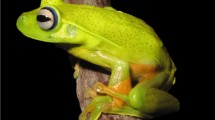Abstract
Male and female brown planthoppers, Nilaparvata lugens(Stål) (Homoptera: Delphacidae), exchange substrate-transmitted signals prior to mating. The pulse repetition frequency of the male song is known to be involved in mate recognition and also to vary among geographical populations. Here the variability of male signals, female signals, and female preferences has been examined within a population. Female preference variation has been partitioned into variation in mean preference and variation in the window of preference of individuals. The genetic component of variation has been examined using isofemale lines. Male signal variation was limited (CV=8%) and was mainly within individuals. Female signal variation was greater (CV=15%). Female mean preference varied little (CV=10%) and was closely matched to the male signal mean, but the preference window was wide (> 4 male signal standard deviations on average) and variable (CV=56%). There was evidence for genetic variation only for preference window. These results are discussed in relation to theories of signal system evolution.
Similar content being viewed by others
References
Bradbury, J. W., and Andersson, M. B. (eds.) (1987).Sexual Selection: Testing the Alternatives, Wiley, New York.
Butlin, R. K., and Hewitt, G. M. (1986). Heritability estimates for characters under sexual selection in the grasshopperChorthippus brunneus.Anim. Behav. 34: 1256–1261.
Claridge, M. F. (1985). Acoustic signals in the Homoptera: Behaviour, taxonomy and evolution.Anna. Rev. Entomol. 30: 297–317.
Claridge, M. F., Den Hollander, J., and Morgan, J. C. (1984). Specificity of acoustic signals and mate choice in the brown planthopperNilaparvata lugens.Entomol. Exp. Appl. 35: 221–226.
Claridge, M. F., Den Hollander, J., and Morgan, J. C. (1985a). Variation in courtship signals and hybridization between geographically definable populations of the rice brown planthopper,Nilaparvata lugens (Stål).Biol. J. Linn. Soc. 24: 35–49.
Claridge, M. F., Den Hollander, J., and Morgan, J. C. (1985b). The status of weed-associated populations of the brown planthopper,Nilaparvata lugens (Stål)—host race or biological species?Zool. J. Linn. Soc. 84: 77–90.
Claridge, M. F., Den Hollander, J., and Morgan, J. C. (1988). Variation in hostplant relations and courtship signals of weed-associated populations of the brown planthopper,Nilaparvata lugens (Stål), from Australia and Asia: A test of the recognition species concept.Biol. J. Linn. Soc. 35: 79–93.
Collins, R. D., and Cardé, R. T. (1989). Selection for altered pheromone-component ratios in the pink bollworm moth,Pectinophora gossypiella (Lepidoptera: Gelechiidae).J. Insect Behav. 2: 609–621.
Collins, R. D., and Cardé, R. T. (1990). Selection for increased pheromone response in the male pink bollworm,Pectinophora gossypiella (Lepidoptera: Gelechiidae).Behav. Genet. 20: 325–331.
Coyne, J. A., and Orr, H. A. (1989). Patterns of speciation inDrosophila.Evolution 43: 362–381.
De Jong, M. C. M., and Sabelis, M. W. (1991). Limits to runaway sexual selection: The wallflower paradox.J. Evol. Biol. 4: 637–655.
De Winter, A. J., and Rollenhagen, T. (1990). The importance of male and female behaviour for reproductive isolation inRibautodelphax planthoppers (Homoptera: Delphacidae).Biol. J. Linn. Soc. 40: 191–206.
Gerhardt, H. C. (1987). Evolutionary and neurobiological implications of selective phonotaxis in the green treefrog,Hyla cinerea.Anim. Behav. 35: 1479–1489.
Helversen, D. von, and Helverson, O. von (1983). Species recognition and acoustic localization in acridid grasshoppers: A behavioural approach. In Huber, F., and Markl, H. (eds.),Neuroethology and Behavioural Physiology, Springer, Berlin, pp. 95–107.
Ichikawa, T. (1979). Studies on the mating behaviour of four species of auchenorrhynchous Homoptera which attack the rice plant.Mem. Fac. Agr. Kagawa Univ. 34: 1–60.
Kaneshiro, K. Y. (1989). The dynamics of sexual selection and founder effects in species formation. In Giddings, L. V., Kaneshiro, K. Y., and Anderson, W. W. (eds.),Genetics, Speciation and the Founder Principle, Oxford University Press, New York, pp. 279–296.
Kaneshiro, K. Y. (1990). Natural hybridization inDrosophila, with special reference to species from Hawaii.Can. J. Zool. 68: 1800–1805.
Kaneshiro, K. Y., and Boake, C. R. B. (1987). Sexual selection and speciation: Issues raised by HawaiianDrosophila.Trends Ecol. Evol. 2: 207–212.
Kyriacou, C. P., and Hall, J. C. (1984). Learning and memory mutations impair acoustic priming of mating behaviour inDrosophila.Nature 308: 62–65.
Lande, R. (1981). Models of speciation by sexual selection on polygenic traits.Proc. Natl. Acad. Sci. USA 78: 3721–3725
Löfstedt, C. (1990). Population variation and genetic control of pheromone communication systems in moths.Entomol. Exp. Appl. 54: 199–218.
Parsons, P. A. (1980). Isofemale strains and evolutionary strategies in natural populations.Evol. Biol. 13: 175–217.
Paterson, H. E. H. (1985). The recognition concept of species. In Vrba, E. S. (ed.),Species and Speciation, Transvaal Museum, Pretoria, pp. 21–29.
Reynolds, J. D., and Gross, M. R. (1990). Costs and benefits of female mate choice: Is there a lek paradox?Am. Nat. 136: 230–243.
Schüch, W., and Barth, F. G. (1990). Vibratory communication in a spider: Female responses to synthetic male vibrations.J. Comp. Physiol. A 166: 817–826.
von Schilcher, F. (1976). The functions of pulse song and sine song in courtship ofDrosophila melanogaster.Anim. Behav. 24: 622–625.
West-Eberhard, M. J. (1983). Sexual selection, social competition, and speciation.Q. Rev. Biol. 58: 155–183.
Author information
Authors and Affiliations
Rights and permissions
About this article
Cite this article
Butlin, R.K. The variability of mating signals and preferences in the brown planthopper,Nilaparvata lugens (Homoptera: Delphacidae). J Insect Behav 6, 125–140 (1993). https://doi.org/10.1007/BF01051499
Accepted:
Issue Date:
DOI: https://doi.org/10.1007/BF01051499




